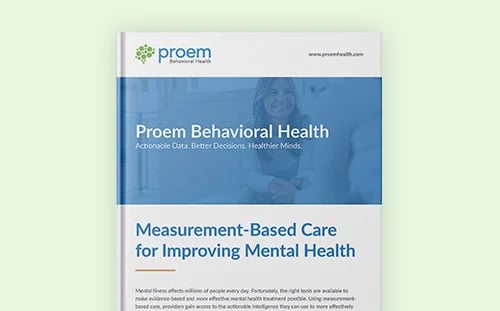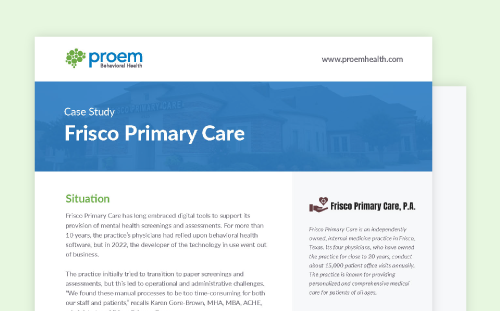Anxiety and substance use disorder (SUD) are among the most common psychiatric diagnoses in the United States, with a respective lifetime prevalence of 28.8% and 14.6%. Psychiatric Times has noted that in any 12 months, 33% to 45% of individuals with anxiety disorder will present with an SUD.

Given the widespread nature of these conditions, it's likely that substance use disorder (SUD) clinics will provide support services to individuals with anxiety symptoms. To best serve these patients, providers must understand both disorders and be able to develop integrated treatment plans when they co-occur.
Pathways for Co-Occurrence
Co-occurring anxiety and substance abuse influence each other's presentation and development. A study published in Clinical Psychology Review concluded the following: "Anxiety disorder and alcohol use disorder each appear to have the capacity to serve as a causal stimulus in the development of the other. Prospective studies show that having either an anxiety disorder alone or an alcohol use disorder alone predicts the later development of the other. … Either an anxiety disorder or alcohol dependence can serve as a causal stimulus for the other and… anxiety disorder can contribute to the persistence of pathological alcohol use."
While determining causation is not always possible, researchers have identified several common scenarios in which an anxiety disorder or an SUD accelerates the development of the other condition. Understanding these causal pathways can help providers to watch for co-occurrence.
Alcohol and Mental Health: Neurological Connections
Chronic substance misuse can alter brain structure and function. According to a study published in Psychiatric Annals, abused substances affect the neurotransmitter systems involved in anxiety. In time, these effects can manifest as a diagnosable anxiety disorder.
Additionally, the individual may develop a greater tolerance for substances when substance use becomes chronic. As the body's substance response diminishes, the brain requires larger quantities to achieve similar effects. The resulting intake increase may accelerate anxiety or substance use disorder development.
Self-Medication in Individuals With Anxiety
For some individuals, self-medication can create a pattern that worsens anxiety and alcohol dependence. According to American Addiction Centers, "Alcohol and drug use can worsen the psychological and physical symptoms of anxiety, reinforcing the need to use more of these substances to function normally. The result is a cycle of substance abuse that can lead to chemical dependence and addiction."
Although self-medication does not cause addiction, it increases an individual's substance consumption. Continuing excessive consumption can lead to dependence or addiction, often at a level that leads to withdrawal symptoms.
Withdrawal as an Anxiety Trigger
Regardless of whether alcohol use stems from self-medication, excessive consumption increases an individual's likelihood of withdrawal. Anxiety and agitation are common symptoms of withdrawal — a particularly problematic connection for those with or prone to anxiety disorders.
As researchers noted in the previously mentioned Clinical Psychology Review article, this may lead to a "feed-forward cycle of increasing anxiety symptoms and alcohol use." If comorbidity is not already present, this ongoing cycle could trigger its development. Clinicians must closely track patients' substance use and anxiety patterns and address any changes as soon as possible.
 Follow Proem Behavioral Health on LinkedIn to help you stay current with the latest behavioral and mental health news.
Follow Proem Behavioral Health on LinkedIn to help you stay current with the latest behavioral and mental health news.
Shared Neurological Factors in Anxiety and Addiction
One of the significant challenges in treating anxiety and substance abuse is the broad symptom overlap between the conditions. Anxiety disorders, particularly generalized anxiety disorder (GAD), often cause patients to appear restless, on edge, irritable or hyperactive. Those symptoms are also present in many individuals with an SUD.
Such overlapping symptoms speak to an overlapping etiology. Researchers have identified several biological connections between the two disorders. For example, as the National Institute of Mental Health has noted, mental health disorders, including SUD and anxiety disorder, may occur across generations of a family.
Researchers are unsure what causes generational recurrence, but the prevailing theory points to a combination of genetics and environmental influences. For example, if an individual's neurology predisposes them to develop an anxiety disorder, parental behavior or a stressful or traumatic environment can trigger that disorder. Sometimes, a parent's trauma may affect family interactions in ways that spark a child's anxiety or substance use tendencies.
Trauma and substance abuse have high comorbidity rates, potentially due to a shared neurological characteristic that affects fear and stress processing. If someone experiences a traumatic event, neurological alterations may impact their ability to process fear-related emotions, increasing susceptibility to anxiety and SUD.
The Case for a Comprehensive Approach to Alcohol and Mental Health Treatment
Researchers have associated comorbid trauma and substance abuse with poorer outcomes, including higher hospitalization rates and functional impairment. To give patients the best possible chance of a positive outcome, providers must treat trauma, anxiety and substance abuse as connected disorders. This requires a comprehensive and integrated treatment model, which considers the presence of the three disorders and the additional risks of comorbidity.
An integrated treatment avoids parallel but disconnected treatment strategies, which can unknowingly worsen one disorder to treat the other(s).
For example, although benzodiazepines have proven effective treatments for panic and anxiety disorders, their abuse potential may increase the risk of SUD relapse. Other pharmacological therapies, including specific agents prescribed for SUD, have more positive addiction and anxiety outcomes. Achieving an optimal treatment plan is only possible when clinicians understand and consider all presenting diagnoses.
Integrated treatment strategies also improve the quality of non-pharmacological interventions, which are critical in patients with substance use disorder. Research suggests that individuals with histories of trauma and substance abuse may feel conflicted about needing medication, making psychosocial treatments a more appropriate primary choice.
Regardless of whether a treatment plan includes medication, providers benefit from considering how an intervention will affect each identified condition. Such an approach requires an accurate diagnostic picture and the ability to monitor patients' progress and share progress reports with patients, which can aid in engagement and adherence to a successful treatment plan.
Strengthen Anxiety and Addiction Interventions by Improving Diagnosis Accuracy
Effective screening is the first step to treating co-occurring anxiety and substance abuse. This screening must be universal and not limited to "suspected" co-occurring disorders, especially given the symptom overlap of these conditions.
Contemporary digital assessment tools put universal screening within even the busiest provider's reach. Proem's clinically validated behavioral health assessment tools, including licensed digital screenings and assessments, integrate smoothly into existing workflows and assess for all major behavioral health conditions, reducing missed diagnoses and identifying more comorbidities and co-occurring conditions, including SUD and anxiety disorders.
To find out how Proem solutions can help with achieving better SUD outcomes, book a meeting today.















